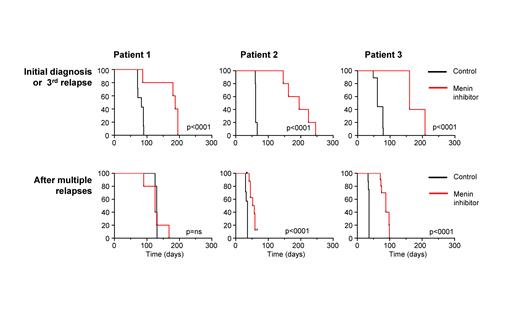Inhibitors of the Menin-KMT2A interaction are emerging as promising agents for the treatment of KMT2A-rearranged ( KMT2A-r) acute myeloid leukemia (AML) and acute lymphoblastic leukemia (ALL). Menin is required for the recruitment of the KMT2A-fusion to a subset of its target genes. Early phase clinical trials have shown highly encouraging results in patients with relapsed and refractory leukemias with KMT2A rearrangements and NPM1 mutations. In a recently reported early phase clinical trial evaluating the Menin inhibitor revumenib, about 50% of patients failed to show a clinical response despite robust downregulation of known Menin:KMT2A target genes, suggesting on target activity of the drug. This was the most common pattern of upfront resistance.
We sought to understand upfront resistance (in contrast to the reported induced resistance via MEN1 mutations) in patient derived xenograft models. To this end, we evaluated the efficacy of Menin-inhibition in KMT2A-r leukemias with high-risk features: high-risk KMT2A fusion partners in AML ( MLLT10, MLLT4), infant ALL, and serial samples from patients with multiply relapsed ALL. We found that AML samples with high-risk fusion partners banked at initial diagnosis were sensitive to Menin-inhibition in xenografts. In contrast, three highly pretreated samples from patients with KMT2A-AFF1 ALL showed only a slight, or no decrease in latentcy in the Menin-inhibitor arm. Interestingly, Menin inhibition showed excellent in vivo efficacy against leukemia samples obtained from the same three patients earlier in their disease course. Therefore, prior chemotherapy (+/- immunotherapy) selects for Menin-inhibitor resistant cells without prior exposure to Menin inhibitor. Transcriptomic analysis (RNA-Seq) documents sustained on-target efficacy of the Menin inhibitor on a transcriptional level in resistant cells. None of the samples contained a MEN1 mutation at any time point. Targeted panel sequencing at initial diagnosis and relapse documented clonal evolution and the emergence of multiple co-mutations (particularly RAS pathway mutations and TP53 mutations), however, all co-mutations tested failed to induce resistance as a single alteration. It is possible that the cooperation of multiple emerging mutations (rather than a single mutation) is sufficient to drive AML in a KMT2A-fusion independent manner, thus mediating Menin resistance.
A transcriptomic response (i.e. downregulation of KMT2A-fusion target genes) without a clinical response was the most common pattern of upfront resistance in the recently reported phase I/II clinical trial of the Menin inhibitor revumenib. We conclude that it will be critical to use Menin-inhibitors upfront or in early lines of therapy before substantial clonal evolution has occurred.
Disclosures
Tasian:Beam Therapeutics: Research Funding; Syndax Pharmaceuticals: Membership on an entity's Board of Directors or advisory committees; Incyte Corporation: Research Funding; Amgen: Other: travel support ; Kura Oncology: Membership on an entity's Board of Directors or advisory committees, Research Funding; Aleta Biotherapeutics: Membership on an entity's Board of Directors or advisory committees. Carroll:Cartography Bioscences: Membership on an entity's Board of Directors or advisory committees; Janssen Pharmaceuticals: Consultancy. McGeehan:Syndax: Current Employment. Bernt:Syndax: Other: Syndax provided mouse chow for experiments.


This feature is available to Subscribers Only
Sign In or Create an Account Close Modal